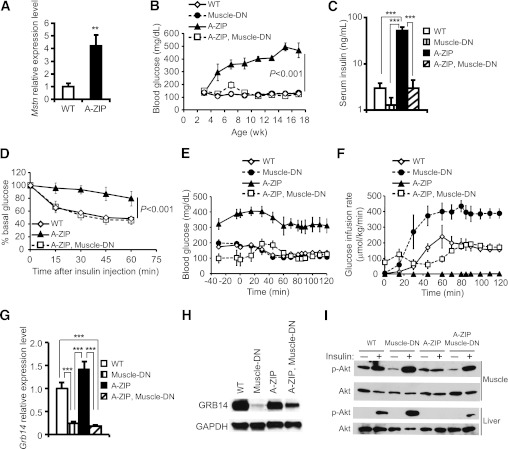FIG. 1.
Amelioration of diabetes by muscle-specific inhibition of MSTN signaling in A-ZIP mice. A: Mstn mRNA levels in gastrocnemius muscles of A-ZIP (n = 7) vs. WT mice (n = 6). B: Blood glucose levels in male WT mice, Muscle-DN mice, A-ZIP mice, and A-ZIP, Muscle-DN mice taken biweekly (n = 6 for each genotype). C: Serum insulin concentrations of male mice measured at age 5 months (n = 4–6 for each genotype). D: Insulin tolerance tests performed on fed male WT mice, A-ZIP mice, and A-ZIP, Muscle-DN mice at age 12 weeks (n = 5–6 for each genotype). E: Plasma glucose concentration before and during hyperinsulinemic-euglycemic clamp starting at time 0 (n = 5–7 for each genotype). F: Glucose infusion rate during clamp (n = 5–7 for each genotype). G: Grb14 mRNA levels in gastrocnemius muscles (n = 5–6 for each genotype). H: Representative Western blots of GRB14 protein levels in quadriceps muscle relative to GAPDH. I: Representative Western blots of p-Akt (Ser473) in gastrocnemius muscle and liver samples in response to intraperitoneal insulin injection (n = 3 for each genotype). Results are presented as mean ± SEM. B and D: Significance of repeated-measures ANOVA is marked. **P < 0.01, ***P < 0.001.

